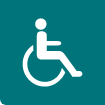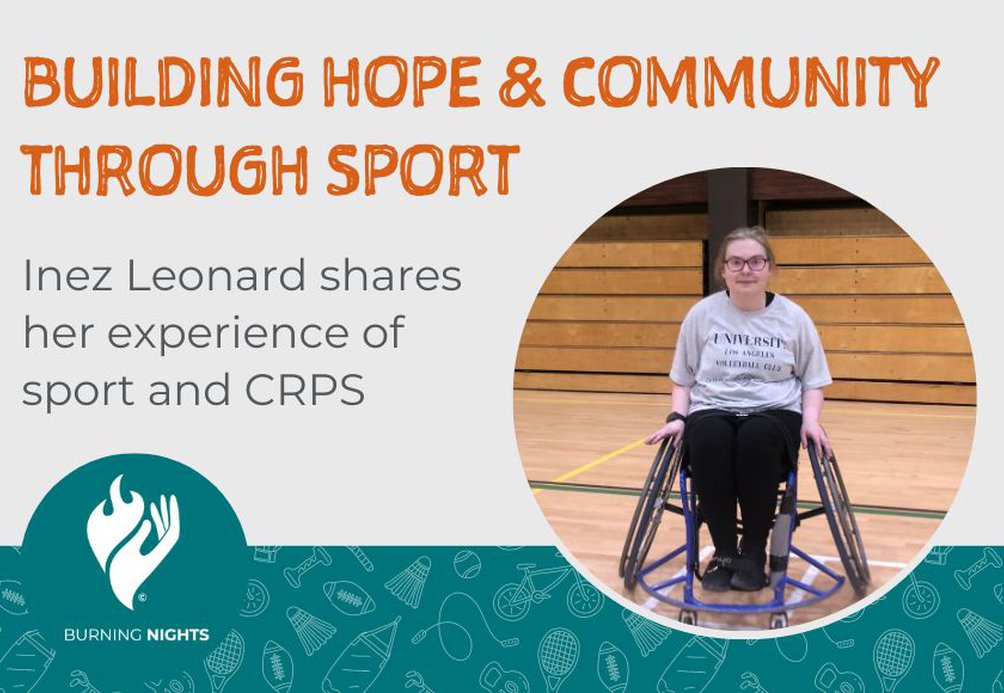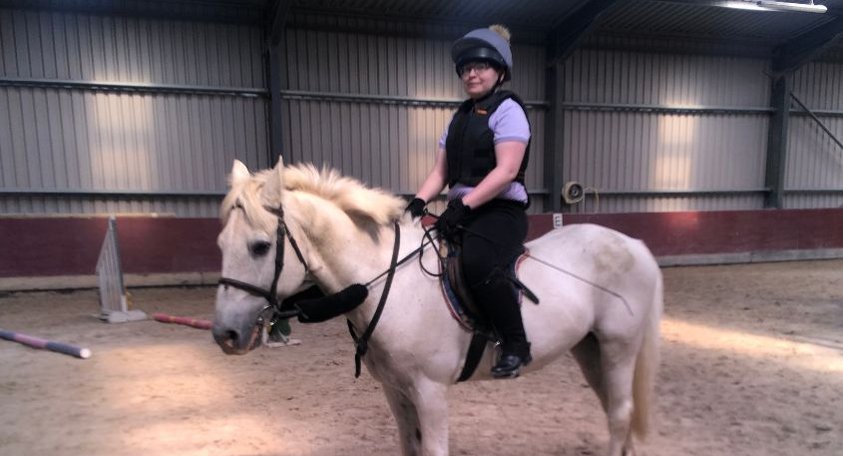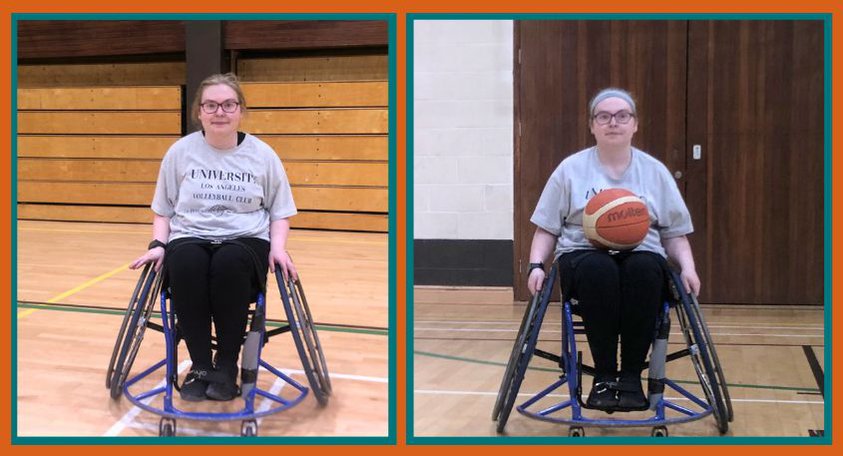We use cookies to improve your experience. By accepting you agree to our cookie policy

A diagnosis of Complex Regional Pain Syndrome (CRPS) can feel like a crushing end to sporting aspirations, especially for young people.
However, 20-year-old Inez Leonard has refused to allow CRPS – and the challenges of accessibility – to take sport away from her.

Inez had her CRPS diagnosis confirmed in 2023. It affects her left lower leg and she’s increasingly reliant on crutches and a wheelchair.
Having always been an active person, who particularly loves horse riding, Inez found a way to get back into the saddle.
She was riding again a year after the accident that triggered her CRPS.
Riding – usually once a week for half an hour – has proved invaluable to Inez’s mental health.
It has helped to improve her core stability and balance, while also being an excellent non-weight-bearing activity for her legs.
Inez also plays wheelchair basketball once a week with her local team in Ireland and trains regularly at the gym with a personal trainer.

Inez began visiting the gym soon after her accident and strongly believes that it slowed the progression of her CRPS.
Muscle wastage, and the resulting loss of function, is a significant challenge of the condition. Until only recently Inez had lost very little tone in her affected limb, due, she feels, to her work at the gym.
Strength training also seems to improve the blood flow in her leg – poor circulation being another CRPS symptom.
Inez continues to visit the gym, adapting exercises to meet her capabilities. Working with a personal trainer, she focuses on upper body and core exercises to help maintain her independence in everyday life.
“Don’t go to the gym alone – work with a personal trainer,” Inez advises. “They don’t have to be a disability specialist, but someone prepared to think flexibly and adjust exercises to meet your potential.
And if you’re not getting what you need then try a new trainer or a new gym.”
Inez is clear that, more often than not, there are ways to keep sport and training a part of your life – it’s lack of accessibility and support that’s the obstacle.
As with many aspects of life with CRPS, taking part in sport is not easy.
To horse ride and play wheelchair basketball, Inez manages her pain and muscle spasms with medication.
It’s also a challenge to tolerate the safety straps that hold players in their basketball wheelchairs should they be knocked over.
So why do it at all?
“Nothing’s going to pull that spark of hope from me,” she says, “I’m holding onto it.”
CRPS can be isolating, with the opportunity to enjoy shared experiences limited by pain or access needs.
If you’re at school and disabled you may be left on the edge of PE lessons feeling ‘othered’. The focus becomes what you can’t do.
In contrast, Inez says:
“Come to wheelchair basketball and everyone’s in! It’s about what you can do; what you bring to the team."
Inez describes a sense of community and the joy of participating on a level playing field.

To take part in sport, CRPS warriors will need to find adaptations that work for them – possibly getting creative in the process.
Inez has taped padding to the left side of her sports wheelchair so, if there is contact with her chair during a game, her leg is cushioned from the frame. Her teammates also try to avoid bashing into her at speed!
When horse riding, Inez uses magnetic stirrups, with a special insole in her boot, to hold her foot in place. Another strap ties the stirrup to the girth to stop her leg flapping and banging against the side of the horse.
With significant support from her riding instructor, Inez has learned to use a long whip instead of her left leg.
“Without my instructor, and her willingness to think out-of-the-box, I wouldn’t be riding today. My horse has needed re-schooling and two people help me get into the saddle.
But it works and I can ride!”
Sports and leisure facilities are not consistently wheelchair accessible.
Inez reminds council groups often that, "being disabled is the only minority group you can become part of at any time." Accessibility must be prioritised.
In her experience, many sports facilities are not built with consideration for wheelchair users and other people with access requirements. In her local sports complex, entry to the gym is via steps and the lift is broken. Her basketball team is forced to use a fire exit into the sports hall and the gym is unusable to anyone who has difficulty with stairs.
Inez is also aware that her current riding arrangements may have to change because of accessibility challenges. Whilst her old stables helped her get back to riding, they don’t have a mounting ramp or hoist. If her legs become completely unable to weight-bear, the mounting block she currently uses will no longer be an option to get onto her horse.
There are limited numbers of riding for the disabled stables in Ireland – and unfortunately none close to Inez.
The International Paralympic Committee (IPC) has deemed pain a ‘non-eligible impairment’ within their official classification code for disability.
As a result, people with chronic pain conditions, like CRPS, are excluded from competing at the Paralympic Games. This has had a huge impact on potential Paralympic athletes. For example, British wheelchair basketball player and CRPS warrior, George Bates, could not join the team he helped to qualify for Tokyo 2020.
The decision of the IPC does not just impact participation in the Paralympic Games, it also prevents Inez from competing competitively in para-sport. Through the lens of the official system, she does not have a disability.
"CRPS doesn’t tick the right boxes,” Inez says.
Whilst competition is not her primary goal, Inez finds it frustrating to have had that path shut off.
“There should be a way to keep people like me involved in competitive sport. Perhaps CRPS and similar chronic pain conditions could have their own category to compete within?”
British Dressage does offer a dispensation for reasonable adaptations that would allow some athletes to continue to compete in able-bodied competitions – but this is not available in Ireland where Inez lives.
Following three years of consultation, the new IPC classification rules (applicable from 1st January 2025) still exclude pain-related conditions.
For Inez, this has certainly cast the Paris 2024 Paralympic Games – which open on 28th August 2024 – in a different light. She won’t be following them closely, although might catch some of the equestrian and basketball events.
Despite the obstacles, Inez is determined to go after the things she wants to achieve.
“The future can change in a split second. So, if I want to do something, I do it now!”
For example, before her accident she had accepted a university place to study Paramedic Science. She had to turn that down but, instead, got involved in setting up her local first responder group. “I couldn’t be a paramedic, but I had enough mobility to do this.”
Inez can no longer be a community first responder but does not regret getting involved while she could. In her view, "knowing that you may have to stop in the future, is never a reason not to start!"
Inez is now studying Social Care Practice and has just completed year one of four.
The awareness of how quickly a path can change, or be cut-off, drives Inez to do what she can, while she can.
She believes she is living more fully now than before her accident.
Inez urges more people to participate in sport as much as is possible for them. They need more women, and young people in general, in her basketball team.
If you’ve been thinking about it, her message is:
“Do it!
Be as active as you can for as long as you can. Don’t be deflated if you have a bad training session - but play in each one as if it’s your last."
Follow Inez on Instagram at @inez_para_sport. Inez is happy to receive any questions from the Burning Nights community on her experience of sport and CRPS – please reach out to her on Instagram.
Burning Nights CRPS Support provides free mental health support and counselling to young people affected by CRPS, whether living with the condition or as a sibling or carer. For more information please get in touch or message us on Instagram.
We use cookies to improve your experience. By accepting you agree to our cookie policy
 £
£